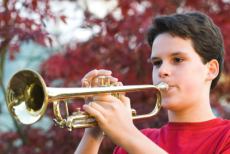
Brass instruments, found in orchestral, big band and jazz music are one of the most well-known families of musical instruments, being made up of popular instruments such as the trumpet, tuba and horn. In this set of articles, we’re going to get to know the brass family a little more closely, and try and understand what separates them from other instrument families. They are quite similar to the woodwind family, in that both produce sound by blowing air through a resonation tube. One of the key differences, of course, is that the majority of brass instruments are brass, and woodwind are not. However, this explanation does not hold up for instruments such as the saxophone, which is a woodwind instrument. In fact, the main thing that sepeartes the two groups is in the way that the vibrations are produced in the tube. In woodwind instruments, the vibrations are made with an embouchure hole in the instrument, or with reeds which vibrate when air is blown between them. On the other hand, in Brass Instruments, the vibrations are typically made when the lips are buzzed into the cup-shaped mouthpiece. This gives the brass instruments a different tone to the woodwind instruments.
Like with the wind instruments however, the size of the instrument generally dictates the deepness of the instruments sound. Brass instruments are often much lower in pitch than woodwind instruments, which is why they can be much larger in size. When you look at a tuba or trombone, you’ll notice they are big tubes coiled around many times to produce a nice deep sound.
Brass instruments are thought to have first been used in Ancient Greece, and Ancient Rome, making them extremely old. Back then, as well as metal, they would have been made from wood and bone. During the Renaissance period in around the 15th century, the Brass instruments started to look a lot more like the modern ones we know today. The first trumpets were developed between 1400 and 1413, and the first trombone was created in around 1450. The earliest piece written specifically for Brass Instruments was in 1597, by the Italian composer Giovanni Gabrieli in Venice. Horns were around at this time, but it was not for centuries that they would come to be used a musical instruments. At this point they were used more for practical functions, such as during hunts or to announce an entrance. Brass instruments continued to be used in orchestral arrangements into the 20th century, and they indeed still are today. Of all the groups of instruments, they have one of the grandest sounds, which is why they have been used popularly in film scores, such as that for Star Wars in 1977. In the 1920s, the trumpet and trombone first started to be used in jazz music, and this helped to push the technical abilities of brass musicians even further.
If you’ve read my articles on the Woodwind family, then you may realise that the Brass family are played in a very similar manner. They have buttons on the outside that are attached to metal flaps elsewhere on the outside of the instrument, and these flaps open and close when buttons are pressed creating different notes. As with Woodwind instruments, they can only play a single note at a time, so for chords to be produced, there must be several instruments playing at once.
Now that we’ve covered the basic style, structure and history of brass instruments, in the next article, I’m going to go into a little more detail about the individual instruments that make up the brass family.
Image from: https://affiliate.rentmyinstrument.com/images/boy_trumpet.jpg

0 Comment:
Be the first one to comment on this article.